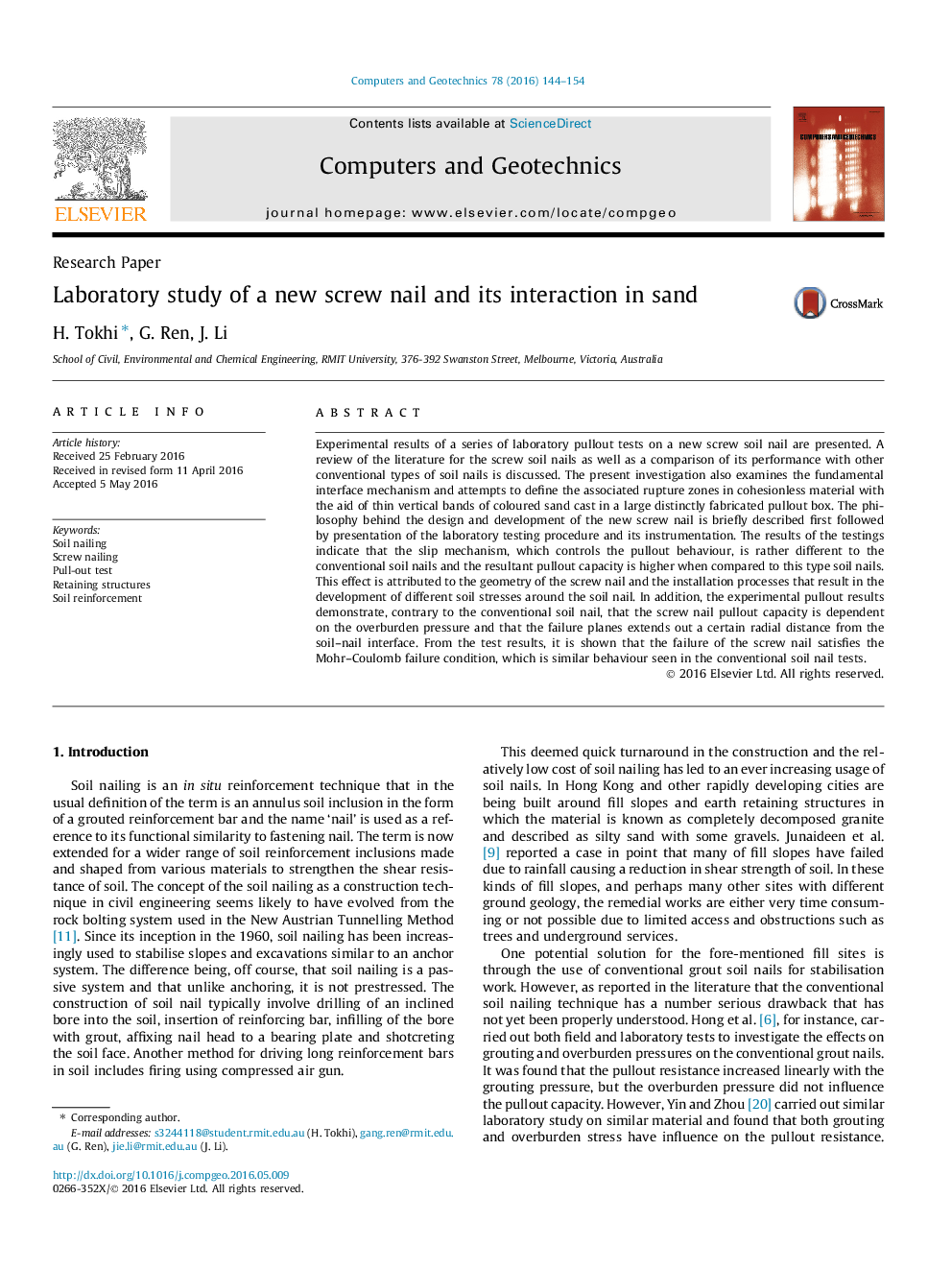| کد مقاله | کد نشریه | سال انتشار | مقاله انگلیسی | نسخه تمام متن |
|---|---|---|---|---|
| 6710364 | 503311 | 2016 | 11 صفحه PDF | دانلود رایگان |
عنوان انگلیسی مقاله ISI
Laboratory study of a new screw nail and its interaction in sand
ترجمه فارسی عنوان
مطالعه آزمایشگاهی ناخن پیچ جدید و تعامل آن در شن و ماسه
دانلود مقاله + سفارش ترجمه
دانلود مقاله ISI انگلیسی
رایگان برای ایرانیان
کلمات کلیدی
ناخن های خاک ناخن اسکرو، تست کشش، ساختارهای نگهدارنده، تقویت خاک،
ترجمه چکیده
نتایج تجربی از یک سری آزمایشی آزمایش کششی بر روی یک ناخن خم پیچ جدید ارائه شده است. بررسی ادبیات ناخن های خاکستری پیچ و همچنین مقایسه عملکرد آن با سایر انواع ناخن های خاکستری مورد بحث قرار گرفته است. تحقیق حاضر همچنین مکانیزم رابط اساسی را مورد بررسی قرار می دهد و تلاش می کند تا با استفاده از نوارهای عمودی نازک ذرات ریخته گری رنگی در یک جعبه خروجی قابل ملاحظه ساخته شده، مناطق ناگهانی مربوط به مواد انبساطی را تعریف کند. فلسفه طراحی و توسعه ناخن پیچ جدید به طور خلاصه توضیح داده شده و سپس ارائه روش آزمایش آزمایشگاهی و ابزار دقیق آن است. نتایج آزمایش ها نشان می دهد که مکانیزم لغزش، که رفتار رفتار خروجی را کنترل می کند، نسبت به ناخن های معمولی خاک متفاوت است و ظرفیت خروجی در مقایسه با این نوع ناخن های خاکی بیشتر است. این اثر به هندسه ناخن پیچ و فرآیندهای نصب شده منجر می شود که منجر به ایجاد تنش های مختلف خاک اطراف ناخن خاک می شود. علاوه بر این، نتایج آزمایش خروجی نشان می دهد، بر خلاف ناخن خاکستری معمولی، که ظرفیت خروج ناخن اسکرو به فشار بیش از حد بستگی دارد و این که خطوط شکست از یک فاصله مشخص رادیویی از رابط رابط بین ناخن ها گسترش می یابد. از نتایج آزمون، نشان داده شده است که شکست ناخن اسکرو به شرایط شکست موری-کولن رضایت می دهد که رفتار مشابهی در آزمون های ناخن های معمولی دیده می شود.
موضوعات مرتبط
مهندسی و علوم پایه
مهندسی کامپیوتر
نرم افزارهای علوم کامپیوتر
چکیده انگلیسی
Experimental results of a series of laboratory pullout tests on a new screw soil nail are presented. A review of the literature for the screw soil nails as well as a comparison of its performance with other conventional types of soil nails is discussed. The present investigation also examines the fundamental interface mechanism and attempts to define the associated rupture zones in cohesionless material with the aid of thin vertical bands of coloured sand cast in a large distinctly fabricated pullout box. The philosophy behind the design and development of the new screw nail is briefly described first followed by presentation of the laboratory testing procedure and its instrumentation. The results of the testings indicate that the slip mechanism, which controls the pullout behaviour, is rather different to the conventional soil nails and the resultant pullout capacity is higher when compared to this type soil nails. This effect is attributed to the geometry of the screw nail and the installation processes that result in the development of different soil stresses around the soil nail. In addition, the experimental pullout results demonstrate, contrary to the conventional soil nail, that the screw nail pullout capacity is dependent on the overburden pressure and that the failure planes extends out a certain radial distance from the soil-nail interface. From the test results, it is shown that the failure of the screw nail satisfies the Mohr-Coulomb failure condition, which is similar behaviour seen in the conventional soil nail tests.
ناشر
Database: Elsevier - ScienceDirect (ساینس دایرکت)
Journal: Computers and Geotechnics - Volume 78, September 2016, Pages 144-154
Journal: Computers and Geotechnics - Volume 78, September 2016, Pages 144-154
نویسندگان
H. Tokhi, G. Ren, J. Li,
